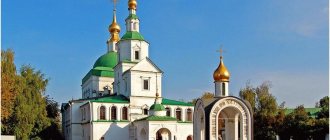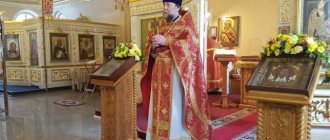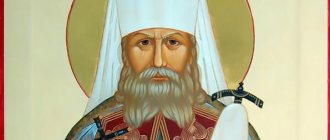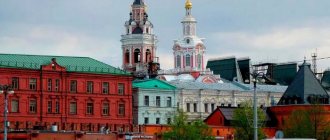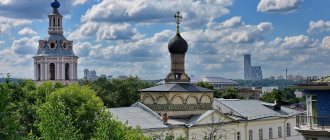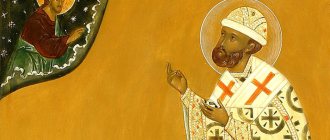Cathedral of St. Peter
Patronal feast days : January 3 – St. Peter, Metropolitan of Kiev, first Moscow wonderworker (1326) .
September 6 – transfer of the relics of St. Peter (1479).
Archaeologists tend to believe that the current temple was built in 1514–1517. on the site of a wooden temple that had fallen into disrepair. It is believed that the first church on this site was dedicated to the apostles Peter and Paul and that Metropolitan Peter was its founder in 1315. The name of the temple is associated with the heavenly patron of the first Moscow saint. And even after the canonization of Metropolitan Peter and the consecration of the temple in his honor, the monastery was still called Peter and Paul for a long time. At the beginning of the 16th century, the Grand Duke of All Rus' John III decided to rebuild the temple in stone, but soon died. The construction of the temple is continued by his successor, Grand Duke Vasily III.
The construction was headed by the Italian architect Aloiso Lamberti da Montagna, better known in Rus' as Aleviz the New, the builder of the Archangel Cathedral in the Kremlin and 10 other churches in different parts of Moscow. He, as the executor of grand ducal orders, had a special task - to create the image of a temple-monument, majestic and holistic. This building, like most Moscow buildings of the 16th century, was supposed to become a kind of symbol of the rise of Moscow. And the process of comprehension itself was directly connected with High Hierarch Peter and, of course, it is not by chance that in the construction of the temple Aleviz turned to an architectural form that was new to Moscow.
Patrimony of Emperor Peter I
Being the first stone building of the monastery, Metropolitan Peter's Cathedral becomes the starting point for the construction of subsequent centuries and the center of the entire ensemble.
The Vysoko-Petrovsky Monastery is perhaps one of the very few examples of stone church construction by Peter I in Moscow. Subsequently, the emperor will create his new city, where there will be new architecture, majestic and festive, with luxurious palaces and grandiose cathedrals, but while he is in Moscow, his gaze is turned specifically to the Vysoko-Petrovsky Monastery, which is closely connected with the history of his family on the maternal side . When talking about the Cathedral of Metropolitan Peter, it is important to note that the fundamental changes in the architectural appearance of the royal orders did not greatly affect the main cathedral of the monastery, although they made its appearance more ceremonial and elegant. By 1690, the cathedral was being rebuilt: the slit-like windows and portals were cut out, the decor was changed (it is known that by order of Peter I the facade was richly decorated with paintings, fragments of which have survived to this day). In general, the changed appearance of the cathedral brought it very close to the buildings of the late 17th century, which subsequently began to mislead many researchers, since the cathedral existed in this form until the restoration of the 1980s. L.A. Belyaev, an archaeologist, researcher at the Institute of Archeology of the Russian Academy of Sciences, who worked on excavations and restoration of the cathedral in the 1980s, notes a paradoxical fact: in the 19th century no one doubted the antiquity of the cathedral, but in the 20th century this knowledge was lost and erroneous dating arose.
As a result, the only way to gain lost knowledge was field research, namely archaeological excavations. Here it is worth noting the special contribution to the research of this monument by B.P. Dedushenko, who headed archaeological excavations and restoration work at the Vysoko-Petrovsky Monastery in the 1980s. It was he who managed to establish that Metropolitan Peter’s Cathedral was indeed built at the beginning of the 16th century.
Then, in 1986, the temple was returned to its original appearance, and one of the unique examples of 16th-century architecture, which revealed a unique synthesis of Italian and Russian traditions, was returned to Moscow.
Rose with eight petals
It must be said that the period of creativity of Italian architects in Moscow is a particularly important stage in the formation of architectural forms new to Rus', which later became the basis for the emergence of new styles in Russian architecture. The Church of Metropolitan Peter is one of the most striking examples of Italian buildings unique in their form in Moscow, not inferior, perhaps, even to the Archangel Cathedral of the Kremlin, which served as the source of the so-called “Italianisms” in Russian architecture. The issues of the existence of “Italianisms” in Russian architecture were dealt with by L.A. Batalov, but it concerned mainly the main building of Aleviz - the Archangel Cathedral; regarding the Cathedral of Metropolitan Peter, this issue remains poorly researched.
When creating the main cathedral of the monastery, the Italian master resorted to a very rare type of centric temple, quadrifolia (“quatrefoil”). In addition, during the construction of the cathedral, Aleviz Novy complicated the “quadrifolium” design; as a result, the cathedral’s plan forms an eight-petaled rose – an octaconch.
Here it is appropriate to cite another fact that is extremely important for the modern study of this monument: thanks to the latest archaeological research of the Church of the Great Martyr Barbara on Varvarka Street in Moscow, it was established that the initial construction of the Varvara Church was also headed by Aleviz Novy. The plan of the Aleviz building, as in the Cathedral of Metropolitan Peter, was based on a quadrifolium, as evidenced by the preserved foundation of the early 16th century. Now on this site is a temple of the same name, built in the 18th century by the architect Rodion Kazakov in the classicism style.
The fact that Aleviz the New built more than one temple of this rare type is extremely curious, and the more valuable for us is the fact that Metropolitan Peter’s Cathedral has been preserved and has hardly lost its original appearance.
The starting point of the “Naryshkin Baroque”
Regarding the architectural forms of Peter's Cathedral, it is also very important to remember that authoritative historians of architecture of the 20th century, such as M.A. Ilyin or P.A. Rappoport, in his works attributed the cathedral to the period of the “Naryshkin Baroque”.
“Naryshkin Baroque” is the conventional name for the style of Russian architecture of the late 17th – early 18th centuries. The most characteristic buildings of this style were erected in the Moscow and Moscow region estates of the Naryshkin boyars. In the “Naryshkin Baroque”
the traditions of ancient Russian white stone patterning and new trends borrowed from Western European architecture were combined. Buildings of this style are characterized by elegance, decorativeness, social cheerfulness, and a major color scheme - a contrasting combination of red walls and white carved details. In the buildings of the “Naryshkin Baroque”, elements of the order began to be widely used (decorative pediments, half-columns, pilasters, arches), as well as decorations in the form of shells and volutes, tiered, pyramidal compositions of buildings. A striking example of the “Naryshkin baroque” is the Church of the Intercession in Fili.
Undoubtedly, the Cathedral of Metropolitan Peter (an early monument with a centric tiered pyramidal composition) served as a model for a whole line of development of churches of centric composition in Moscow architecture at the end of the 17th - beginning of the 18th centuries, which largely determine for us the appearance of the unique “Naryshkin Baroque”. It is worth remembering that the Baroque style originally originated in Italy at the end of the 16th century. And, perhaps, it is not at all by chance that in Rus' it was the monument of the 16th century, built by an Italian architect (the bearer of the culture that shaped the Baroque style), that became one of the starting points for the emergence of its indirectly borrowed Baroque forms in Russian architecture. Unfortunately, it is still little known which prototypes in Italian architecture, available to Aleviz Novy, the architect could have taken as the basis for the construction of the cathedral. The study of this issue is open to research. So we cannot talk about direct borrowing, but it is not difficult to trace the connection on the general cultural subtext.
It is especially significant that the main ensemble of the monastery gravitates specifically towards the Naryshkin Baroque, and when Peter I changed the appearance of the facade of the temple, expanding the windows and decorating it with fancy decor, the temple organically merged with the later style of the entire ensemble, which allowed researchers to mistakenly attribute it to a later period . But, as we see, modern research clearly demonstrates the opposite.
The connection between Metropolitan Peter's Cathedral and the architecture of the 17th century is justified by the fact that the forms of the cathedral became one of the main starting points for the emergence of the entire movement of “Naryshkin Baroque”. Thus, we are talking not just about an ancient cathedral in a unique state of preservation, but about an important, key monument in the history of all Russian architecture.
On September 6, 2014, His Holiness Patriarch Kirill of Moscow and All Rus' consecrated the Petrovsky Church of the Vysoko-Petrovsky Monastery.
Daria Gordienko
- 135shares
- 132
- 1
- 1
- 1
- Share
The generosity of the Naryshkin boyars
The heyday of the monastery is associated with the royal family of the Naryshkins. At the end of the 17th century, Peter the Great's grandfather, Kirill Naryshkin, married his daughter Natalya Kirillovna to Tsar Alexei Mikhailovich. Shortly before the birth of his grandson, the future Emperor Peter I, Kirill Poluektovich Naryshkin was promoted to nobleman, and then to boyar.
The Naryshkin estate was located next to the Vysoko-Petrovsky Monastery. The family, delighted with the birth of an heir, little Petenka, donated the estate to the monastery. So the territory of the monastery grew 2 times. At the expense of the Naryshkin boyars, a stone monastery complex was built at the end of the 17th – beginning of the 18th centuries. In 1735, 70 inhabitants lived in the monastery, and the monastery was owned by 6,000 peasants.
Necropolis
Since the 15th century, brethren and noble residents of Moscow have been buried in the monastery cemetery. During archaeological excavations, burials from the 17th century with sarcophagi and tombstones were discovered. Extracted from the ground, they are put on display at the southern wall of the Church of Sergei of Radonezh, awaiting burial.
The monastery territory, cutting into it like a wedge, is occupied by the walking and playground of kindergarten No. 878. The territorial dispute between the Vysoko-Petrovsky Monastery and the preschool institution is resolved by the Moscow government.
Shrines of the monastery
- Miraculous icons of the Mother of God: Kazan, Tolga, Inexhaustible.
- Chalice with upcoming saints.
- Part of the relics of St. Peter, Metropolitan of Moscow.
- Particles of the relics of Saints Peter and Paul.
- Particles of the relics of St. Spyridon of Trimythous.
- Particles of the relics of the holy martyr Thaddeus of Tver.
Particles of the relics of the saints:
- Sergei of Radonezh;
- Seraphim of Sarov;
- Job Pochaevsky;
- Neil Stolobensky;
- Alexy and German Zosimovsky;
- Kiev-Pechersk venerable saints.
The Vysoko-Petrovsky Monastery, located in the central part of Moscow, on the corner of Petrovka Street and Petrovsky Boulevard, is sandwiched by Moscow high-rise buildings and narrow streets, which is why people often call it “invisible” and few people know about it. Nevertheless, the monastery attracts pilgrims from all over Russia and neighboring countries as a center of spiritual life and a complex of cultural monuments.
The fate of the monastery in the 20th century
After the arrival of Soviet power, the monastery was liquidated, the burial place of the Naryshkins was destroyed, and a repair plant was created in the temple. There were also gyms and offices, foundries and libraries, and communal apartments.
Urban planning plans included the demolition of the ancient monastery to widen the highway. Fortunately, this did not happen, and in 1959 the monastery received the status of an architectural monument .
In 1994, the ancient buildings were transferred to the church, where the Russian Orthodox Institute of St. John the Theologian began to operate. On October 10, 2009, monastic life resumed at the monastery.
